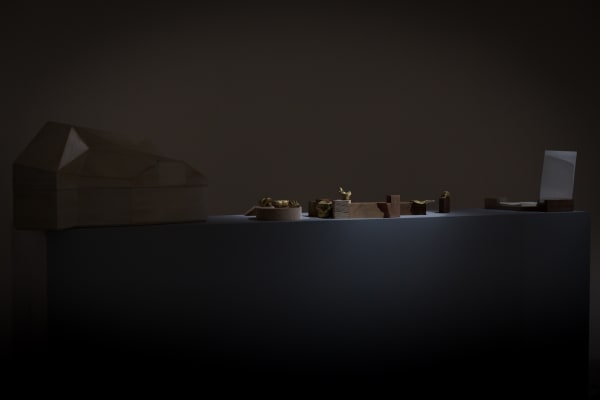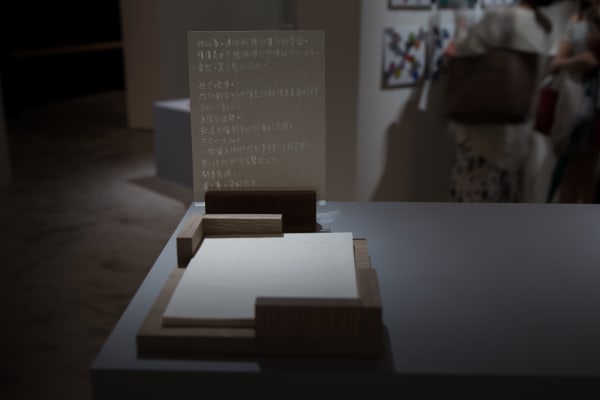OCAC Group Exhibition 2016: Open Contemporary Art Center
OCAC Group Exhibition 2016 is a creative collaboration among nine members of the Open Contemporary Art Center. The lack of a specific title for the exhibition offers an chance to reflect upon how an artist, as part of a co-run organization, constructs a relationship with other members through his or her own art practice. Cultural objects — the point of departure of this exhibition — refer not only to the physical existence of mundane objects, but to the identity and function of these objects in a social context. When Duchamp placed a daily object in an art context in 1917, which transformed "something ready-made" into a "readymade," a work of art, he also paved the way for future artists to blur or break boundaries. Mass-produced, commonplace objects have since become raw material with which artists experiment and recreate. In their appropriation of ordinary objects, artists scrutinize how these objects are used in their original social domain. Instead of dismantling old paradigms, the concept of readymades is then refined, and forms the bedrock of another aesthetic.
Inspired by Chinese modern art master painter Sanyu (常玉) (1901-1966), Syu Jia Jhen (b. 1986) entitles his work "常鬱," changyu, pronounced similarly as the painter's name, meaning "melancholy," hence the English title that echoes the artist's state of mind. Based not upon the image of Sanyu's painting, Melancholy shares a connection to Sanyu's work through the sense of smell instead of sight, expanding the concept of cultural objects. Hsu Chia Wei (b. 1983) looks upon the work of Taiwanese painter Yang San Lang (1907-1995), who once travelled France, as his source of inspiration. Naming his own work after Yang's Old Alley in Paris (1933), Hsu Chia Wei transports the viewer to Paris more than 80 years ago. Through documents, press clippings, and visiting the streets Yang once roamed, Hsu Chia Wei pieces together a picture of the past with his photography and novel. The personal histories of the predecessors serve as a conduit through which Syu Jia Jhen and Hsu Chia Wei channel their creative energy into contemporary thinking.
Taking a different approach to his art practice, Chiu Chen Hung (b. 1983) based his Marble Memento on anonymous local marble sculptures, chiseling and carving them into entities that are no longer defined by their preexisting figurative details, in an attempt to capture the pristine state of stone. This reverse operation disguised as an act of restoration is really deep contemplation on what it means to produce art. Working under the premise that art production is inevitable and necessary, Lo Shih Tung (b.1983) explores the character of a gallery in Moonlight in Multiverse. He ruminates what defines a gallery space, a supposedly neutral domain that is called the white box. By interviewing gallery staff and visitors, the artist documents words and phrases that are said during the interview, which are then engraved onto multiple tiny wood balls. These wood balls are arranged in a random manner, where the inscriptions on them could fall into meaningful sentences, while the unfixed position of these spheres implies the elusive, loosened, and fluid consciousness lurking beneath the curved wood surface.
Veering away from the application of cultural objects in the art system, Lin Wen Tsao (b. 1977) uses toy blocks as a creative element and migration as a cultural background in his work Blocks, where he examines the anxieties and recollections stemming from the change in environments. The sight of toy blocks stacked high up like a tower reminds viewers of their own childhood days when they once too stacked up toy blocks, which seemed so big for their tiny hands that the wood block tower appeared to be falling apart, just as the tumultuous times we inhabit. Wu Chien Hsing (b. 1987) adopts a similar approach of building blocks in Furniture Event I, where several dented kitchen knives are lodged into each other to form an intricate, forbidding table stand. It is anything but toy blocks that facilitate children’s imagination and creativity. This reverse operation mirrors a social reality that is poignant, cold, and inorganic.
Chen Chia Jen (b. 1976) espouses a reverse operation that is meant to beautify in Sweet Water, where he observes the massive amount of refuse produced by modern industrial society, and documents their existence in different corners and watercourses of the city, reimagining his act as still life portraiture. Sweet Water is also meant as a response to tang shui pian (糖水片), a popular term in China literally meaning "candied photography," which refers to photography that demonstrate superb landscape techniques. With Sweet Water, the artist questions how garbage in the river could be transformed into cultural objects. Kao Hsuan (b. 1990) conjures a hideaway for love in Garden Retreat, alluding to an escape from past loves. She made a multimedia light box where the image on the bottom appears obscure, while the burning candle inside melts away and dripping wax slowly covers the image. In this way the artist accomplishes her final escape in her work of art.
OCAC Group Exhibition 2016 is more than a display of respective works by the member artists of the organization. It also embodies the relationship among individuals, objects, and their synergy, which expands through the gallery and art collection mechanism. The concept behind each work and the combination of objects become the formative elements in the finalization of the exhibition. The exhibition designer Shih Pei Chun (b. 1985) cultivates her creativity through practices of art making, architecture design, and patchwork. She has designed twice for the OCAC space, both the old one in Shihlin, and the new one on Ganzhou Street that recently opened in April. Her ability to adapt different spaces to new needs attests her attempt to interweave diverse practices. Looking back on the turning point at which she shifted from art training to architecture training, she reexamines the design that not only is meant for architecture and nature to grow and bond, but also creates a space where the OCAC members can engage in dialogues in their separate art practices. The state of artistic unison and scatteredness, in turn, manifests itself in what could ultimately be seen as a landscape installation in an architectural system.















